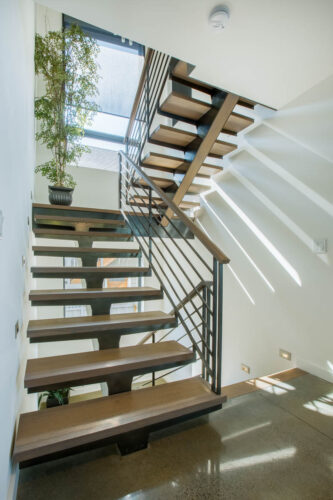Welcome the Sun Indoors
 The solar orientation of a home will affect the level of comfort experienced inside. A few key design moves can help lower energy bills and increase interior comfort.
The solar orientation of a home will affect the level of comfort experienced inside. A few key design moves can help lower energy bills and increase interior comfort.
Orientation
The orientation of a home will set the stage for how much solar energy can be harvested to warm the indoors throughout the winter. The longest side of the house should face south so that a large portion of the wall area has access to direct sunlight. Depending on what rooms are most occupied, these should be located at the south side of the house.
Window Placement
To take advantage of the sun’s heat during the winter the southern façade will benefit from large windows. Depending on the latitude of the building’s location, the sun will reach varying heights in the sky during the winter season. But its height in the winter is always lower than in the summer, therefore penetrating deeper into the house. Taking advantage of this sustainable approach to heating a home can reduce the amount of forced air necessary to heat the indoors. In the Pacific Northwest, the majority of the year requires heating, so designing for the cold time of year is important.
Roof Overhang
 Of course, it’s also important to remember the hot summer months. In the summer the sun is higher in the sky. Therefore the sun’s rays strike the house at a steep angle so that the direct sunlight is less likely to travel as deep inside. To keep out the sun’s heat it is important to block direct sunlight from reaching the windows. Roof overhangs play an important role in shading the window area from the sunshine. A larger roof overhang will be more effective. Designing a roof overhang correctly to block the sun in the summer but allow the sun’s rays indoors during the winter can be tricky and requires fine-tuning.
Of course, it’s also important to remember the hot summer months. In the summer the sun is higher in the sky. Therefore the sun’s rays strike the house at a steep angle so that the direct sunlight is less likely to travel as deep inside. To keep out the sun’s heat it is important to block direct sunlight from reaching the windows. Roof overhangs play an important role in shading the window area from the sunshine. A larger roof overhang will be more effective. Designing a roof overhang correctly to block the sun in the summer but allow the sun’s rays indoors during the winter can be tricky and requires fine-tuning.
While these are ideal steps to take for improving interior comfort levels, home owners can encounter obstacles which require compromises. Such obstacles include north-south lot orientations, existing coniferous trees blocking access to the sun, in addition to nearby neighboring houses obstructing the southern exposure.
Whatever the location of your home, it is possible to plan for and reap the benefits of solar orientation, whether that may be for a newly constructed home, or a remodel for a home that is already standing. Taking initial steps for a well-oriented house is valuable to residents and is environmentally sound.
In addition these are also the first steps in designing a net-zero home, something a homeowner may strive for now or in the future. Taking advantage of the sun’s path throughout the different seasons can lead to a brighter and warmer home. And let’s not forget about the saving that can be made from lower heating bills.
Written by Carmen Ulrich, Architectural Designer at H2D Architecture + Design



